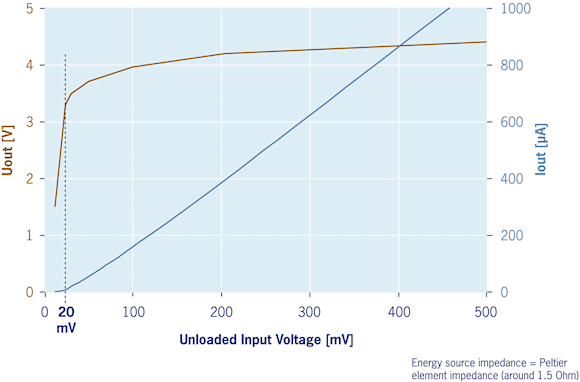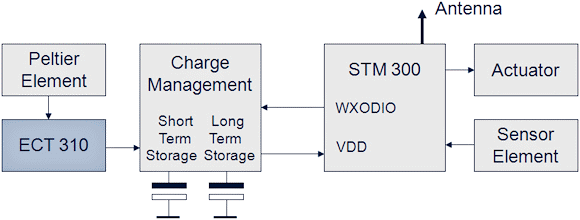Before energy harvesting and self-powered sensors were available, integrators were limited to line-power and batteries when powering building automation system devices. The wires required for lighting and HVAC systems made it difficult to reach all the corners of buildings and batteries introduced maintenance issues into the equation that the building automation system (BAS) market has been unwilling to tolerate.
In the early 2000s, EnOcean introduced an energy harvesting wireless standard and technology that stemmed from a simple observation—where building sensor data resides, sufficient ambient energy exists to power sensors and radio communications. Since its inception, applications for self-powering wireless sensors and controls for building automation have steadily increased. Lighting and HVAC energy management systems provide a rich habitat for the development of sensor-driven systems that regulate the energy flow in buildings. A decade ago only a handful of energy harvesting wireless sensors existed. Now, system integrators have hundreds of self-powered sensor solutions at their disposal.
Thermoelectric power generation has been added to the mix of power sources available to OEMs and their customers. Thermoelectric energy harvesting widens the scope of applications to include those that operate in the dark. Pipes and ducts, for example, frequently exist in dark places that are not appropriate for light- or motion-based energy harvesting. Thermal energy harvesting can capture the power from the temperature differentials that are abundant in those dark spaces, enabling its use to power HVAC controls such as water valves, variable air volume vents (VAVs), and diffusers. In some cases, wireless sensor applications can power electronic circuits using temperature differentials as small as 2°C. By converting temperature differentials into usable power, this new class of sensors and switches can reduce energy consumption by as much as 40%.
Capturing Energy in the Dark
Temperature differentials contain a lot of energy; cooling a drop of water by 2°C releases enough energy to power 20,000 RF transmissions when operating on the EnOcean Wireless Standard. Thermo-harvesting can power wireless sensors and a number of wireless actuators.
When EnOcean went to market in 2003 with its first series of energy harvesting wireless products, their devices were powered by energy produced by motion or from light. An alternative to solar panels for applications with limited light is a radio module that can be powered by other external power sources such as a thermoelectric generator, which is based on a standard Peltier element. Such an energy source can deliver enough energy to power ultra-low-power EnOcean RF modules. An energy storage device, such as a supercapacitor, provides a reservoir for harvested energy and provides the short-term burst current required by the radio module.
 Figure 1. The ECT 310 DC/DC converter works on as little as 20 mV, corresponding to a 2°K temperature difference |
For all of the innovation that is taking place in energy harvesting, its widespread adoption will depend on its cost-effectiveness. For instance, inexpensive thermoelectric elements are employed in beverage coolers, where an electric current applied to a Peltier element chills the contents. EnOcean reverses this effect: the temperature differential generates the electrical energy to power a sensor. However, low-cost Peltier elements have a pronounced drawback in that they only produce voltages of about 10 mV/°K. An EnOcean sensor module for example, needs a typical supply voltage of 3 V. Consequently, a new kind of DC/DC converter concept was needed to boost these very low voltage outputs to a level usable for traditional electronics. EnOcean's ECT 310 DC/DC converter (Figure 1) includes an optimized oscillator that starts to resonate at input voltages above 10 mV (Figure 2). A central component of the converter is the coil seen in Figure 1, which is a transformer with a gain of 1:100.
 Figure 2. ECT 310 output voltage versus input voltage |
Basic Principle of Thermoelectric Energy Harvesting
 Figure 3. Energy-autonomous sensor for airflow temperature |
EnOcean manufactures a family of sensor modules that enables the design of a compact, modular, energy-autonomous wireless sensor. Attached to the rear of the module is either the ECT 310 converter or a solar cell. Variants have either a whip or helical antenna and operate at 868 MHz (Europe) or 315 MHz (in the USA, Japan, China). Energy storage and energy management for a typical duration of four days without energy input are factory-integrated and three analog and three digital measuring inputs are implemented on a connector. The module also has a microcontroller for data processing, including a software stack for the wireless protocol (equipment profile of EEP 2.0 specification), and predefined firmware that the user can reprogram for a specific application, such as preprocessing sensor data.
 Figure 4. Block diagram of a thermally powered wireless sensor |
It is important to fully isolate the energy supply from the sensor circuitry: the module may be powered by temperature, but it can measure entirely different process variables such as pressure or humidity.
Integration of the Peltier Element
Figure 5 illustrates the typical integration of a low-cost Peltier element. The efficiency of energy generation depends on the thermal transfer resistance between the hot and cold sides of the Peltier element. It is therefore necessary to ensure good thermal insulation surrounding the two ceramic wafers, for instance by using a suitable plastic or Styrofoam material. The size of the Peltier element should allow the use of a suitably thick insulating material that does not complicate its mechanical integration. When using a heat sink the effective thermal resistance depends on heat-sink geometry and the flow of the surrounding air.
 Figure 5. Thermal insulation surrounding the Peltier element |
The ECT 310 is unipolar so it is important to ensure the correct polarity of the Peltier element. If the environment changes, e.g., the hot side becomes the cold side, two ECT 310 modules can be connected to the Peltier element in an anti-parallel circuit.
Energy Storage
The following sections address some of the most important variables to consider when designing a wireless energy-harvesting device. In these applications, where minuscule amounts of energy are harvested, it is often necessary to store the harvested energy in a reservoir for later use. With most energy-harvesting devices, it is likely that the source of the ambient energy will not always be present. For instance, in the case of solar harvesting, light may not always be available, making energy storage a necessity.
An increasingly popular energy storage reservoir for energy-harvesting applications is the supercapacitor or ultracapacitor. These electrochemical capacitors have a relatively large volumetric energy density when compared with traditional ceramic, electrolytic, or tantalum capacitors, as shown in Figure 6. Supercapacitors tolerate hundreds, thousands, and even millions of charge-discharge cycles, which is two to three orders of magnitude greater than is possible with rechargeable batteries. Supercapacitors can also be charged/discharged very quickly. While their volumetric energy density is a couple of orders of magnitude less than typical primary lithium cells, when combined with an energy harvester, such as a solar cell, they never need replacement. Additionally, they don't contain toxic chemicals.
 Figure 6. Volumetric energy density |
The proper selection and sizing of a supercapacitor for a given application is essential. Their performance is affected by time, temperature, voltage, and charge cycling. Consequently, a capacitor whose initial capacitance and equivalent series resistance (ESR) barely meet the requirements of the application is not recommended. ESR is the quantifiable resistance of all the parts that are used to describe the impedance of electrical components. Because capacitance and ESR degrade as time progresses, designers should determine the minimum voltage and energy requirements of the application and then de-rate the initial capacitance of the supercapacitor.
Delivering Conditioned Air When and Where It Is Needed
Motion- and light-based energy harvesting have enabled OEMs to develop building automation solutions that overcome many of the limits inherent to wires and batteries. Members of the EnOcean Alliance, an international consortium of 200 companies, subscribe to the common goal of reducing building energy waste via energy harvesting and wireless control while maintaining true interoperability between respective Alliance member solutions. Now that thermoelectric energy harvesting is an option, OEMs in the Alliance can develop solutions for a host of new applications.
A Thermo-powered Actuator
Figure 7 shows the output power of the thermal generator as a function of temperature difference. Two curves are plotted; the blue curve represents the actual temperature difference available in the environment (potential differential). The brown curve is the temperature difference across the Peltier element itself (achieved differential). The decrease in output power is attributable to the thermal transfer loss across the heat sink. To illustrate expected performance, approximately 100 µW of energy is produced from a potential temperature difference of 7°C. A typical EnOcean wireless module that wakes up every two minutes to send a message needs about 5 µW; the remaining 95 µW is enough to drive an actuator such as a water valve or an air damper or, alternatively, to store in the capacitor for future usage.
 Figure 7. ECT 310 output power versus temperature difference—approx. 100 µW for 7°C difference from surroundings |
Figure 8 shows a block diagram of such a wireless actuator. In contrast to the all-in-one STM 312 module, the emphasis with the STM 300 used here is on flexibility of application. In addition to the bidirectional wireless communication (important for the actuator mechanism), the charging circuit and therefore the scaling of the energy storage is flexibly configured.
 Figure 8. Block diagram of a thermally powered bidirectional wireless actuator—approx. 5 µW consumption without actuator technology (for wake-up every 2 min.) |
Summary
EnOcean developed the patented ultra-low-voltage DC/DC converter enabling low-cost standard Peltier elements to power batteryless EnOcean wireless modules by harvesting thermal energy. The module works on as little as 20 mV, corresponding to a temperature difference of about 2° K, and exhibits an efficiency of 30% for a 25 mV input voltage.
Harvesting ambient energy with energy-optimized wireless technologies enables a variety of wireless lighting and HVAC sensors and controls. These devices can be easily installed in almost any building, with minimal invasiveness, to help conserve energy and save costs. Tougher environmental standards and soaring fuel costs demand better ways to manage the energy use in buildings and that, in turn, requires technologies that allow such concepts to be speedily and efficiently implemented. Energy harvesting and wireless technologies are two of these technologies.
ABOUT THE AUTHOR
Jim O'Callaghan is President of EnOcean Inc., Boston, MA. He can be reached at 801-312-0114, [email protected].